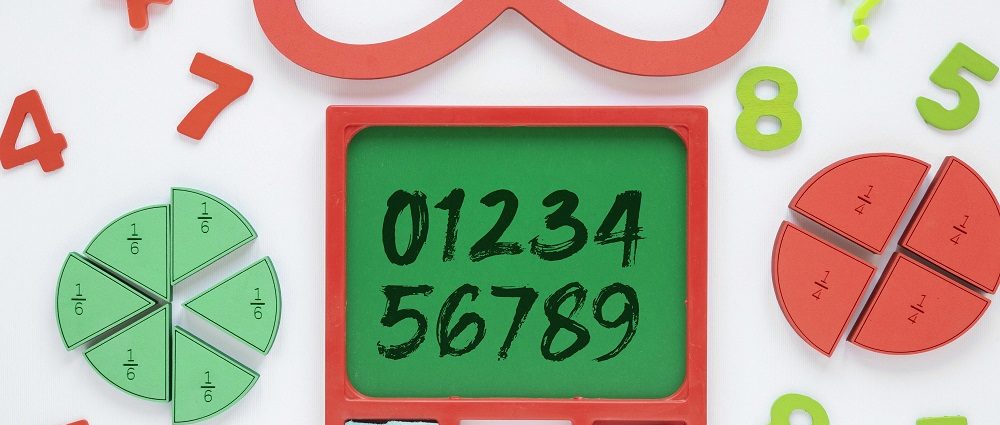Share this
Math manipulatives are physical objects that help students visualize and understand mathematical concepts. They come in various shapes, sizes, and materials and allow young learners to comprehend math problems in a more tangible way. In this article, we will explore the value and types of math manipulatives and learn exactly how they enhance learning and problem-solving skills in students of all ages.
Why are Math Manipulatives Important?

Math manipulatives are tools that play a crucial role in helping children grasp new mathematical concepts and develop their skills. These educational aids provide tangible examples and representations, allowing students to explore and understand concepts from various perspectives, often connected to their everyday experiences. By using concrete examples and objects, children can engage with abstract ideas more effectively, making it easier for them to learn and retain new information.
The process of learning a new math concept can be broken down into three primary stages. Firstly, children are introduced to the idea using concrete examples and objects, enabling them to explore the concept from different angles and develop an understanding of its core principles. Secondly, abstract symbols are introduced to represent the concept. At this point, children must learn to associate the symbols with the previously learned concepts. They may still require support from concrete objects or everyday examples during this stage.
Finally, children reach the point where they can use only the abstract symbols to solve problems, demonstrating that they understand the meaning of the symbols and how to manipulate them correctly. Math manipulatives play a vital role in bridging the gap between the first and second stages of learning a new concept.
One example of the effectiveness of math manipulatives is their use when teaching fractions. Before introducing children to the symbols and calculations involved in fractions, teachers can utilize fraction math manipulatives to help students visualize and understand the concept. By interacting with tools such as fraction strips and circles, children can gain valuable insights into the nature of fractions and how they behave. As they progress and are introduced to fraction symbols, math manipulatives can continue to serve as valuable references, assisting students as they work on more complex fraction problems on paper. The use of manipulatives not only eases the transition from concrete to abstract understanding but also helps to reduce the anxiety often associated with this challenging learning process.
In short, math manipulatives have many benefits, including:
- Improving conceptual understanding through a multisensory experience.
- Encouraging students to think critically and creatively about different mathematical operations.
- Provide assistance in transitioning from doing math with concrete objects to using abstract math symbols.
- Aiding in the development of problem-solving skills.
- Providing opportunities for collaborative learning and discussion.
- Helping students overcome their fear of mathematics by decreasing anxiety and making it more enjoyable and accessible.
Common Types of Math Manipulatives
There are various types of math manipulatives designed for different age groups and mathematical concepts. Some of the most common ones include:
1. Base Ten Blocks

(Photo credit: By Annielogue – Own work, CC BY-SA 4.0, https://commons.wikimedia.org/w/index.php?curid=52740538)
Base ten blocks are a set of four types of blocks, including a unit cube (1), a long rod representing ten units (10), a flat representing 100 units (100), and a large cube representing 1000 units (1000). These blocks help students visualize and understand the base-ten number system, as well as operations like addition, subtraction, multiplication, and division.
2. Geometric Shapes (Pattern Blocks)

(Photo credit: By Annielogue – Own work, CC BY-SA 4.0, https://commons.wikimedia.org/w/index.php?curid=74727176)
Geometric shape manipulatives come in various forms, such as pattern blocks, tangrams, or other types of tiles. These materials help students understand concepts in geometry, spatial reasoning, symmetry, and measurement. They can also be used to explore fractions and patterns.
3. Cuisenaire Rods

(Photo credit: By Annielogue – Own work, CC BY-SA 4.0, https://commons.wikimedia.org/w/index.php?curid=63113057)
Cuisenaire rods are a set of rectangular rods of varying lengths and colors, each representing a different number. They can be used to teach a wide range of mathematical concepts, such as addition, subtraction, multiplication, division, fractions, and even algebraic thinking.
4. Fraction Bars or Circles

Fraction bars or circles are manipulatives designed to help students understand the concept of fractions, decimals, and percentages. They can be used to compare, order, and perform operations with fractions, as well as explore equivalent fractions.
5. Counters
Counters are small, flat objects that can be used for teaching basic counting, sorting, patterning, and simple operations. They come in various shapes, sizes, and colors, which can be an added advantage for teaching sorting and categorization.
Integrating Math Manipulatives into the Classroom and at Home
Incorporating manipulatives in the classroom is easier than one might think. Teachers and parents should take the time to introduce and demonstrate the proper use of these materials before assigning activities. Some tips for integrating manipulatives include:
- Introduce the manipulative and provide ample time for students to explore and become familiar with it.
- In a classroom, create stations or centers dedicated to the use of manipulatives to encourage independent learning.
- In a classroom, offer collaborative, small-group activities that promote communication and problem-solving.
- Blend the use of manipulatives with other strategies, such as direct instruction and guided practice, to deepen understanding and reinforce concepts.
- Allow students to use manipulatives when they start to work on math questions on paper.
Where Can I Get Math Manipulatives
You can purchase math manipulatives from education supply stores or from Amazon. The price may range from 10 dollars to more than 100 dollars depending on what you buy. Most math manipulatives are available between 10 dollars and 40 dollars.
Conclusion
Math manipulatives can play a crucial role in helping students develop a deep understanding and appreciation for mathematics. By incorporating these tools into teaching and learning, educators and parents can provide new opportunities for children to engage with math concepts, think critically, develop their problem-solving skills, and make math more fun.
Richard Zhang, M.Ed., is an educator and a software developer with a Masters degree in education from University of Toronto and an immense passion for education and learning. Until the pandemic, Richard owned an award-winning learning centre in Toronto. For 15 years, he has taught and mentored hundreds of elementary, middle school, and high school students succeed in academics. He is also an app developer specializing in web and mobile application in educational and business sectors.












1 Comment
Comments are closed.